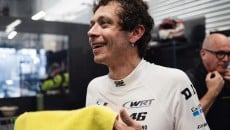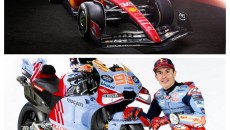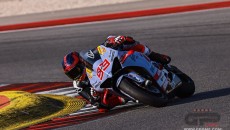The conspiracy theorists went wild over the past few days: Valentino didn’t really have surgery. In fact, he wasn’t even injured. The stolen X-ray is a cover-up. The only thing missing to set the stage for an X-Files episode were chemical trails and Area 51.
Valentino takes in all of these imaginative theories with a smile: “What can I say? Do you want to see the X-rays? Because it isn’t even true that they were stolen. The actual images of my leg were never published anywhere. When certain things happen, people say a lot of stupid things. Ask the doctors if you want. I don’t even care about demonstrating that I was injured.”
But then he concedes and improvises a strip tease, taking off the containing sock, showing the scars from the operation.
Scars aside, the good news is that the leg looks good after 8 laps in the first free practice session and 13 in the second.
“It was a positive day - Rossi clarifies straight away - From the morning I was already feeling good in the saddle and to be honest I didn’t know what to expect, because I hadn’t been on the M1 in leathers since the injury. But the ergonomics of this bike are tailor designed for me and I felt better than on the R1.”
What were your sensations when you started riding?
“I didn’t feel much pain, but the best thing is that after the two sessions the leg did not swell. I feel pretty good.”
Did the wet track help you?
“Physically it is easier to ride in those conditions; it’s less demanding, so it was better to start like that. On the other hand, it is more dangerous and easier to make mistakes. I held back a bit out of fear and left a bit of margin. I didn’t brake on the kerbs and I didn’t even try to turn the bike when I went a little long on the braking sections, which is what you normally do when you ride at the limit. I was a bit more prudent than usual because I am already pleased to be here and to be riding.”
Were you able to allay some doubts with these two sessions?
“No, because riding in the wet is different than riding on a dry track. You hang off the bike a lot less and that is one of the areas where I struggle the most because of the injury.”
Can you tell if you’ll be able to last race distance?
“If it’s a wet race I don’t think I’ll have any particular problems, but with a dry track everything changes. For example, on the braking sections I need to stress the arm and shoulders more because I can’t push on my legs. On a dry track it will be more tiring.”
So do you think you’ll try a long run tomorrow?
“If I am really able to do those 23 laps … then it will be best to save them for Sunday (he laughs). I think I’ll follow a normal work schedule in FP3, trying to dial in the bike and figure out my potential and then try to put on the soft tyres in the finale. The first hurdle will be to get into the top 10, but I really have no idea if I’ll be able to do it. To understand my stamina, I’ll need to trust my sensations.”
Have you modified the bike in some way?
“I used the footpegs in a lower position, but I think that I’ll go back to the standard ones already tomorrow.”










